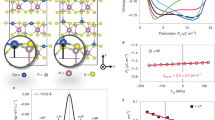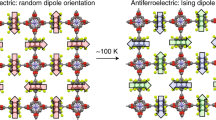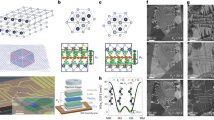Abstract
Sliding ferroelectricity is a recently observed polarity existing in two-dimensional materials. However, due to the weak polarization and poor electrical insulation in these materials, existing experimental evidences are indirect and mostly based on nanoscale transport properties or piezoresponse force microscopy. We report the direct observation of sliding ferroelectricity, using a high-quality amphidynamic single crystal (15-crown-5)Cd3Cl6, which possesses a large bandgap and so allows direct measurement of polarization–electric field hysteresis. This coordination polymer is a van der Waals material, which is composed of inorganic stators and organic rotators as determined by X-ray diffraction and NMR characterization. From density functional theory calculations, we find that after freezing the rotators, an electric dipole is generated in each layer driven by the geometric mechanism, while a comparable ferroelectric polarization originates from the interlayer sliding. The net polarization of these two components can be directly measured and manipulated. Our finding provides insight into low-dimensional ferroelectrics, especially control of the synchronous dynamics of rotating molecules and sliding layers in solids.
This is a preview of subscription content, access via your institution
Access options
Access Nature and 54 other Nature Portfolio journals
Get Nature+, our best-value online-access subscription
$29.99 / 30 days
cancel any time
Subscribe to this journal
Receive 12 print issues and online access
$259.00 per year
only $21.58 per issue
Buy this article
- Purchase on Springer Link
- Instant access to full article PDF
Prices may be subject to local taxes which are calculated during checkout





Similar content being viewed by others
Data availability
The experimental cif files can be found in CCDC (1875017-1875018 and 2160711-2160716). The experimental and DFT optimized structural files were also uploaded as supplementary files. Source data for figures in main text and supplemental information of this paper are available at https://figshare.com/articles/dataset/Direct_observation_of_geometric_and_sliding_ferroelectricity_in_an_amphidynamic_crystal/20102213. Other data supporting these findings are available from the corresponding authors upon request. Source data are provided with this paper.
References
Qi, L., Ruan, S. & Zeng, Y. Review on recent developments in 2D ferroelectrics: theories and applications. Adv. Mater. 33, 2005098 (2021).
Wu, M. Two-dimensional van der Waals ferroelectrics: scientific and technological opportunities. ACS Nano 15, 9229–9237 (2021).
Guan, Z. et al. Recent progress in two-dimensional ferroelectric materials. Adv. Electron. Mater. 6, 1900818 (2020).
Chang, K. et al. Discovery of robust in-plane ferroelectricity in atomic-thick SnTe. Science 353, 274–278 (2016).
Liu, F. et al. Room-temperature ferroelectricity in CuInP2S6 ultrathin flakes. Nat. Commun. 7, 12357 (2016).
Zhou, Y. et al. Out-of-plane piezoelectricity and ferroelectricity in layered α-In2Se3 Nano flakes. Nano Lett. 17, 5508–5513 (2017).
You, L. et al. Origin of giant negative piezoelectricity in a layered van der Waals ferroelectric. Sci. Adv. 5, eaav3780 (2019).
Wu, M. & Li, J. Sliding ferroelectricity in 2D van der Waals materials: related physics and future opportunities. Proc. Natl Acad. Sci. USA 118, e2115703118 (2021).
Li, L. & Wu, M. Binary compound bilayer and multilayer with vertical polarizations: two-dimensional ferroelectrics, multiferroics, and nanogenerators. ACS Nano 11, 6382–6388 (2017).
Fei, Z. et al. Ferroelectric switching of a two-dimensional metal. Nature 560, 336–339 (2018).
Sharma, P. et al. A room-temperature ferroelectric semimetal. Sci. Adv. 5, eaax5080 (2019).
Xiao, J. et al. Berry curvature memory through electrically driven stacking transitions. Nat. Phys. 16, 1028–1034 (2020).
Yasuda, K., Wang, X., Watanabe, K., Taniguchi, T. & Jarillo-Herrero, P. Stacking-engineered ferroelectricity in bilayer boron nitride. Science 372, 1458–1462 (2021).
Stern, M. V. et al. Interfacial ferroelectricity by van der Waals sliding. Science 372, 1462–1466 (2021).
Wan, Y. et al. Room-temperature ferroelectricity in 1T′-ReS2 multilayers. Phys. Rev. Lett. 128, 067601 (2022).
Wang, X. et al. Interfacial ferroelectricity in rhombohedral-stacked bilayer transition metal dichalcogenides. Nat. Nanotech. https://doi.org/10.1038/s41565-021-01059-z (2022).
Wang, Z. et al. Ferroelectricity in strained Hf2CF2 monolayer. Phys. Rev. Mater. 5, 074408 (2021).
Zhang, W. & Xiong, R.-G. Ferroelectric metal–organic frameworks. Chem. Rev. 112, 1163–1195 (2012).
Horiuchi, S. & Tokura, Y. Organic ferroelectrics. Nat. Mater. 7, 357–366 (2008).
Czarnecki, P., Nawrocik, W., Pajak, Z. & Wasicki, J. Ferroelectric properties of pyridinium tetrafluoroborate. Phys. Rev. B 49, 1511–1512 (1994).
Liao, W. Q. et al. A lead-halide perovskite molecular ferroelectric semiconductor. Nat. Commun. 6, 7338 (2015).
Fu, D. W. et al. Diisopropylammonium chloride: a ferroelectric organic salt with a high phase transition temperature and practical utilization level of spontaneous polarization. Adv. Mater. 23, 5658–5662 (2011).
Zhang, Y. et al. Highly efficient red-light emission in an organic–inorganic hybrid ferroelectric: (pyrrolidinium)MnCl3. J. Am. Chem. Soc. 137, 4928–4931 (2015).
Ye, H. Y. et al. Bandgap engineering of lead-halide perovskite-type ferroelectrics. Adv. Mater. 28, 2579–2586 (2016).
Harada, J. et al. Directionally tunable and mechanically deformable ferroelectric crystals from rotating polar globular ionic molecules. Nat. Chem. 8, 946–952 (2016).
You, Y. M. et al. An organic-inorganic perovskite ferroelectric with large piezoelectric response. Science 357, 306–309 (2017).
Ye, H. Y. et al. Metal-free three-dimensional perovskite ferroelectrics. Science 361, 151–155 (2018).
Fu, D. W. et al. 4-Methoxyanilinium perrhenate 18-crown-6: A new ferroelectric with order originating in swinglike motion slowing down. Phys. Rev. Lett. 110, 257601 (2013).
Fu, D. W. et al. Supramolecular bola-like ferroelectric: 4-methoxyanilinium tetrafluoroborate-18-crown-6. J. Am. Chem. Soc. 133, 12780–12786 (2011).
Akutagawa, T. et al. Ferroelectricity and polarity control in solid-state flip-flop supramolecular rotators. Nat. Mater. 8, 342–347 (2009).
Hazell, A., Hazell, R. G., Holm, M. F. & Krogh, L. Structures of the 3:1 adducts of cadmium(II) bromide and of cadmium(II) chloride with 15-crown-5 ether: structural changes induced by radiation. Acta Crystallogr. 47, 234–239 (1991).
Fu, X. B. et al. Revealing structure and dynamics in host–guest supramolecular crystalline polymer electrolytes by solid-state NMR: applications to β-CD-polyether/Li+ crystal. Polymer 105, 310–317 (2016).
Rothwell, W. P., Shen, W. X. & Lunsford, J. H. 31P Solid-state NMR of a chemisorbed phosphonium ion in HY zeolite: observation of 1H-31P J coupling in the solid state. J. Am. Chem. Soc. 106, 2452–2453 (1984).
Shi, C., Zhang, X., Cai, Y., Yao, Y.-F. & Zhang, W. A chemically triggered and thermally switched dielectric constant transition in a metal cyanide based crystal. Angew. Chem. 127, 6304–6308 (2015).
Schmidt-Rohr, K. & Spiess, H. W. Multidimensional Solid-state NMR and Polymers (Academic Press, 1994).
Levitt, M. H. Spin Dynamics: Basics of Nuclear Magnetic Resonance. (John Wiley, 2001).
Kurtz, S. K. & Perry, T. T. A powder technique for the evaluation of nonlinear optical materials. J. Appl. Phys. 39, 3798–3813 (1968).
Lines, M. E. & Glass., A. M. Principles and Applications of Ferroelectrics and Related Materials (Oxford University Press, 1977).
Czapla, Z. & Grigas, J. Microwave dielectric dispersion in diglycine nitrate. Ferroelectrics 100, 187–194 (1989).
Van Aken, B. B., Palstra, T. T. M., Filippetti, A. & Spaldin, N. A. The origin of ferroelectricity in magnetoelectric YMnO3. Nat. Mater. 3, 164–170 (2004).
Rondinelli, J. M., Eidelson, A. S. & Spaldin, N. A. Non-d0 Mn-driven ferroelectricity in antiferromagnetic BaMnO3. Phys. Rev. B 79, 205119 (2009).
Benedek, N. A. & Fennie, C. J. Hybrid improper ferroelectricity: a mechanism for controllable polarization–magnetization coupling. Phys. Rev. Lett. 106, 107204 (2011).
Oh, Y. S., Luo, X., Huang, F.-T., Wang, Y.-Z. & Cheong, S.-W. Experimental demonstration of hybrid improper ferroelectricity and the presence of abundant charged walls in (Ca,Sr)3Ti2O7. crystals. Nat. Mater. 14, 407 (2015).
Liu, M. F. et al. Direct observation of ferroelectricity in Ca3Mn2O7 and its prominent light absorption. Appl. Phys. Lett. 113, 022902 (2018).
Ding, N. et al. Phase competition and negative piezoelectricity in interlayer-sliding ferroelectric ZrI2. Phys. Rev. Mater. 5, 084405 (2021).
Larson, A. C. & Von Dreele, R. B. General Structure Analysis System (GSAS) (Los Alamos National Laboratory Report LAUR 86-748, 1994).
Spek, A. L. PLATON, A Multipurpose Crystallographic Tool (Utrecht University, 2001); http://www.cryst.chem.uu.nl/platon/
Fukunaga, M. & Noda, Y. New technique for measuring ferroelectric and antiferroelectric hysteresis loops. J. Phys. Soc. Jpn. 77, 64706 (2008).
Liu, S. F., Mao, J. D. & Schmidt-Rohr, K. A robust technique for two-dimensional separation of undistorted chemical-shift anisotropy powder patterns in magic-angle-spinning NMR. J. Magn. Reson. 155, 15–28 (2002).
Kresse, G. & Furthmu, J. Efficient iterative schemes for ab initio total-energy calculations using a plane-wave basis set. Phys. Rev. B 54, 11169–11186 (1996).
Perdew, J. P., Burke, K. & Ernzerhof, M. Generalized gradient approximation made simple. Phys. Rev. Lett. 77, 3865–3868 (1996).
Grimme, S., Antony, J. & Ehrlich, S. A consistent and accurate ab initio parametrization of density functional dispersion correction (DFT-D) for the 94 elements H–Pu. J. Chem. Phys. 132, 154104 (2010).
Resta, R. Macroscopic polarization in crystalline dielectrics: the geometric phase approach. Rev. Mod. Phys. 66, 899–915 (1994).
King-Smith, R. D. & Vanderbilt, D. Theory of polarization of crystalline solids. Phys. Rev. B 47, 1651–1654 (1993).
Acknowledgements
We thank D.-W. Fu and H.-F. Lu for their suggestions on project conception and structural analysis, and X. Liu, Z. Sheng and M. Liu for their kind help on SHG analysis and Rietveld refinement. Y.Z. acknowledges support from the National Key Research and Development Program of China (grant number 2017YFA0204800) and the Open Project of Shanghai Key Laboratory of Magnetic Resonance (grant number 2018004). S.D. acknowledges support from National Natural Science Foundation of China (grant number 11834002). L.-P.M. acknowledges support from the Jiangxi Provincial Key Laboratory of Functional Molecular Materials Chemistry (grant number 20212BCD42018). Y.-F.Y. acknowledges support from the Xing-Fu-Zhi-Hua Foundation of ECNU. We thank the Big Data Center of Southeast University for providing the facility support on the numerical calculations.
Author information
Authors and Affiliations
Contributions
Y.Z. and S.D. conceived the project. Y.Z. designed the experiments. S.D. proposed the theoretical mechanisms. L.-P.M. prepared the samples and performed the DSC and SHG measurements. N.W. contributed to PFM measurements. C.S. and H.-Y.Y. contributed to single-crystal measurement and analysis. Y.-F.Y. performed the NMR measurement and analysis. N.D. performed the DFT calculations guided by S.D. L.L. contributed to the analysis of PFM. S.D. and Y.Z. wrote the manuscript, with inputs from all other authors.
Corresponding authors
Ethics declarations
Competing interests
The authors declare no competing interests.
Peer review
Peer review information
Nature Materials thanks Sarah Guerin and the other, anonymous, reviewer(s) for their contribution to the peer review of this work.
Additional information
Publisher’s note Springer Nature remains neutral with regard to jurisdictional claims in published maps and institutional affiliations.
Supplementary information
Supplementary Information
Supplementary Notes 1–3, Figs. 1–14, Tables 1–5 and references 1 and 2
Crystallographic Data 1
Crystal structures of CCC form 253 K to 343 K by experiment
Crystallographic Data 1
CheckCIF/PLATON report
Computational Data 1
Crystal structure of “0+” state by DFT calculation
Computational Data 2
Crystal structure of “+P” state by DFT calculation
Computational Data 3
Crystal structure of “monolayer A” state by DFT calculation
Computational Data 4
Crystal structure of “monolayer B” state by DFT calculation
Computational Data 5
Crystal structure of “0-” state by DFT calculation
Computational Data 6
Crystal structure of “-P” state by DFT calculation
Source data
Source Data Fig. 1
Statistical Source Data
Source Data Fig. 2
Statistical Source Data
Source Data Fig. 3
Statistical Source Data
Source Data Fig. 4
Statistical Source Data
Source Data Fig. 5
Statistical Source Data
Source Data Fig. S2
Statistical Source Data
Source Data Fig. S3
Statistical Source Data
Source Data Fig. S4
Statistical Source Data
Source Data Fig. S7
Statistical Source Data
Source Data Fig. S8
Statistical Source Data
Source Data Fig. S9
Statistical Source Data
Source Data Fig. S13
Statistical Source Data
Source Data Fig. S14
Statistical Source Data
Rights and permissions
About this article
Cite this article
Miao, LP., Ding, N., Wang, N. et al. Direct observation of geometric and sliding ferroelectricity in an amphidynamic crystal. Nat. Mater. 21, 1158–1164 (2022). https://doi.org/10.1038/s41563-022-01322-1
Received:
Accepted:
Published:
Issue Date:
DOI: https://doi.org/10.1038/s41563-022-01322-1
This article is cited by
-
Room-temperature ferroelectricity in magnetically ordered CoH2SeO4 flakes
Science China Materials (2024)
-
Sliding ferroelectricity in van der Waals layered γ-InSe semiconductor
Nature Communications (2023)
-
Large sliding regulation in van der waals layered nonlinear optical ternary chalcogenides
npj Computational Materials (2023)
-
Giant polarization ripple in transverse pyroelectricity
Nature Communications (2023)
-
Photochromic ferroelasticity observed in hybrid lead halide through effective structural regulation
Science China Materials (2023)



